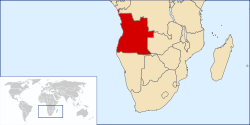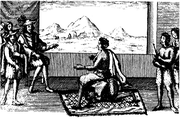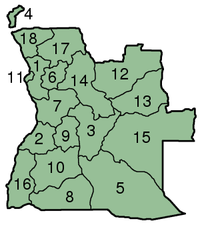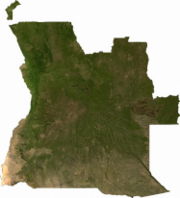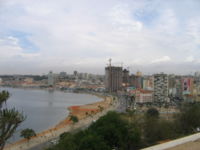Angola
2008/9 Schools Wikipedia Selection. Related subjects: Africa; African Countries
| República de Angola Republic of Angola
|
||||||
|---|---|---|---|---|---|---|
|
||||||
| Motto: "Virtus Unita Fortior" (Latin) "Unity Provides Strength" |
||||||
| Anthem: Angola Avante! (Portuguese) Forward Angola! |
||||||
|
|
||||||
| Capital (and largest city) |
Luanda |
|||||
| Official languages | Portuguese | |||||
| Recognised regional languages | Kongo, Chokwe, South Mbundu, Mbundu | |||||
| Demonym | Angolan | |||||
| Government | Presidential republic | |||||
| - | President | José E. dos Santos | ||||
| - | Prime Minister | Fernando da Piedade Dias dos Santos |
||||
| Independence | from Portugal | |||||
| - | Date | November 11, 1975 | ||||
| Area | ||||||
| - | Total | 1,246,700 km² ( 23rd) 481,354 sq mi |
||||
| - | Water (%) | negligible | ||||
| Population | ||||||
| - | 2005 estimate | 15,941,000 ( 61st) | ||||
| - | 1970 census | 5,646,177 | ||||
| - | Density | 13/km² ( 199th) 34/sq mi |
||||
| GDP ( PPP) | 2005 estimate | |||||
| - | Total | $43.362 billion ( 82nd) | ||||
| - | Per capita | $2,813 ( 126th) | ||||
| HDI (2007) | ▲0.446 (low) ( 162nd) | |||||
| Currency | Kwanza ( AOA) |
|||||
| Time zone | WAT ( UTC+1) | |||||
| - | Summer ( DST) | not observed ( UTC+1) | ||||
| Internet TLD | .ao | |||||
| Calling code | +244 | |||||
Angola, officially the Republic of Angola (Portuguese: República de Angola, pronounced IPA: [ʁɛ'publikɐ dɨ ɐ̃'gɔlɐ] Kongo: Repubilika ya Ngola), is a country in south-central Africa bordering Namibia to the south, Democratic Republic of the Congo to the north, and Zambia to the east, and with a west coast along the Atlantic Ocean. The exclave province Cabinda has a border with the Republic of the Congo and the Democratic Republic of the Congo. Angola was a Portuguese colony from the 16th century to 1975. The country is the second-largest petroleum and diamond producer in sub-Saharan Africa, yet its people are among the continent's poorest. According to the International Monetary Fund, more than $4 billion in oil receipts have disappeared from Angola's treasury in the 2000s. In August 2006, a peace deal was signed with separatist rebels from the Cabinda exclave in the North. About 65% of Angola's oil comes from that region.
History
Khoisan hunter-gatherers are some of the earliest known modern human inhabitants of the area. They were largely replaced by Bantu tribes during Bantu migrations, though small numbers of Khoisan remain in parts of southern Angola to the present day. The geographical areas now designated as Angola first became the subject to incursions by Europeans in the late 15th century. In 1483 Portugal established a base at the river Congo, where the Kongo State, Ndongo and Lunda existed. The Kongo State stretched from modern Gabon in the north to the Kwanza River in the south. Angola became a link in trade with India and Southeast Asia. In 1575 Portugal established a colony at Cabinda based on slave trade. Before the beginning of the Atlantic slave trade, slavery was practiced in Africa by many indigenous peoples. The African slave trade provided a large number of black slaves to Europeans and their African agents. For example, in what is now Angola, the Imbangala had economies which were heavily focused on the slave trade. Within the Portuguese Empire, most black African slaves were traded to Brazilian merchants arrived to Portugal's African ports from other Portuguese colony - Brazil (South America) - seeking cheap workforce for use on Brazilian agricultural plantations. This trade would last until the first half of the 1800s. The Portuguese gradually took control of the coastal strip throughout the sixteenth century by a series of treaties and wars forming the Portuguese colony of Angola. Taking advantage of the Portuguese Restoration War, the Dutch occupied Luanda from 1641 to 1648, where they allied with local peoples to consolidate their colonial rule against the remaining Portuguese resistance.
Colonial era
In 1648, Portugal retook Luanda and initiated a conquest of the lost territories, which restored the pre-occupation possessions of Portugal by 1650. Treaties regulated relations with Congo in 1649 and Njinga's Kingdom of Matamba and Ndongo in 1656. The conquest of Pungo Andongo in 1671 was the last great Portuguese expansion, as attempts to invade Congo in 1670 and Matamba in 1681 failed. Portugal expanded its territory behind the colony of Benguela in the eighteenth century, and began the attempt to occupy other regions in the mid-nineteenth century. The process resulted in few gains until the 1880s. Development of the interior began after the Berlin Conference in 1885, fixed the colony's borders, and British and Portuguese investment fostered mining, railways, and agriculture. Full Portuguese administrative control of the interior didn't occur until the beginning of the twentieth century. In 1951, the colony was designated as an overseas province, called Portuguese West Africa. Portugal had a presence in Angola for nearly five hundred years, and the population's initial reaction to calls for independence was mixed.
Independence
Leftist military officers overthrew the Caetano government in Portugal in the Carnation Revolution on April 25, 1974. The transitional government opened negotiations with the three main independentist guerrilla groups: MPLA, FNLA, and UNITA, concluding separate peace agreements with each organization. With Portugal out of the picture, the nationalist movements turned on each other, fighting for control of Luanda and international recognition. Holden Roberto, Agostinho Neto, and Jonas Savimbi met in Bukavu, Zaire in July and agreed to negotiate with the Portuguese as one political entity. They met again in Mombasa, Kenya on January 5, 1975 and agreed to stop fighting each other, further outlining constitutional negotiations with the Portuguese. They met for a third time in Alvor, Portugal from January 10-15.
Roberto, Neto, Savimbi, and the Portuguese government signed the Alvor Agreement on January 15, setting November 11 as the date for independence. Alvor marked Angola’s transition from the war for independence to the war for Luanda. Portuguese authorities deliberately excluded the Front for the Liberation of the Enclave of Cabinda (FLEC) and Eastern Revolt from participating in the negotiations to ensure Angola’s territorial integrity, in direct opposition to the de Spínola’s plans for Angola. The coalition government the Alvor Agreement established soon fell as nationalist factions, doubting one another's commitment to the peace process, tried to take control of the colony by force.
Civil war
When it was known that Portuguese authorities and military forces would leave the territory and hand over power to the nationalist groups, a mass exodus of civilian Portuguese citizens ensued. The Angolan Civil War (1975 - 2002), one of the largest and deadliest Cold War conflicts, erupted shortly after and lasted 27 years, ravaging the economy, disturbing social order and disrupting social stability in the newly independent country. Over 500,000 people lost their lives, mostly in the 1990s, as the three main factions and several smaller ones struggled for supremacy. Thousands of Angolan refugees suffered with the conflict and left the country or simply fled to other regions of Angola. Today, all parties to conflict are active politically, but the Popular Movement for the Liberation of Angola's (MPLA) victory in the war prevents any opposition candidate or ethnic group from challenging dos Santos and the Kimbundu’s " de facto " control of the country. The MPLA’s base is among the Kimbundu people and the multiracial intelligentsia of Luanda. The National Liberation Front of Angola (FNLA), based in the Bakongo region of the north, allied with the United States, the People's Republic of China and the Mobutu government in Zaïre. The United States, South Africa, and several other African nations also supported Jonas Savimbi's National Union for the Total Independence of Angola (UNITA), whose ethnic and regional base lies in the Ovimbundu heartland of central Angola.
Ceasefire with UNITA
On February 22, 2002, Jonas Savimbi, the leader of UNITA, was killed in combat with government troops, and a cease-fire was reached by the two factions. UNITA gave up its armed wing and assumed the role of major opposition party. Although the political situation of the country began to stabilize, President dos Santos has so far refused to institute regular democratic processes. Among Angola's major problems are a serious humanitarian crisis (a result of the prolonged war), the abundance of minefields, and the actions of guerrilla movements fighting for the independence of the northern exclave of Cabinda ( Frente para a Libertação do Enclave de Cabinda). While most of the internally displaced have now returned home, the general situation for most Angolans remains desperate, and the development facing the government challenging as a consequence.
Politics
Angola's motto is Virtus Unita Fortior, a Latin phrase meaning "Virtue is stronger when united." The executive branch of the government is composed of the President, the Prime Minister (currently Fernando da Piedade Dias dos Santos) and Council of Ministers. Currently, political power is concentrated in the Presidency. The Council of Ministers, composed of all government ministers and vice ministers, meets regularly to discuss policy issues. Governors of the 18 provinces are appointed by and serve at the pleasure of the president. The Constitutional Law of 1992 establishes the broad outlines of government structure and delineates the rights and duties of citizens. The legal system is based on Portuguese and customary law but is weak and fragmented, and courts operate in only twelve of more than 140 municipalities. A Supreme Court serves as the appellate tribunal; a Constitutional Court with powers of judicial review has never been constituted despite statutory authorization.
The current government has announced an intention to hold elections in 2008. These elections would be the first since 1992 and would serve to elect both a new president and a new National Assembly.
Administrative divisions
Angola is divided into eighteen provinces (províncias) and 163 municipalities. The provinces are:
|
|
Exclave of Cabinda
With an area of approximately 7,283 km² (2,800 square miles), the Northern Angolan province of Cabinda is unique in being separated from the rest of the country by a strip, some 60 km wide, of the Democratic Republic of Congo (DRC) along the lower Congo river. Cabinda borders the Congo Republic to the north and north-northeast and the DRC to the east and south. The town of Cabinda is the chief population centre. According to a 1995 census, Cabinda had an estimated population of 600,000, approximately 400,000 of whom live in neighbouring countries. Population estimates are, however, highly unreliable. Consisting largely of tropical forest, Cabinda produces hardwoods, coffee, cocoa, crude rubber and palm oil. The product for which it is best known, however, is its oil, which has given it the nickname, "the Kuwait of Africa". Cabinda's petroleum production from its considerable offshore reserves now accounts for more than half of Angola's output. Most of the oil along its coast was discovered under Portuguese rule by the Cabinda Gulf Oil Company (CABCOG) from 1968 onwards. Since Portugal handed over sovereignty of its former overseas province of Angola to the local independentist groups (MPLA, UNITA, and FNLA), the territory of Cabinda has been a theatre of separatist guerrilla actions opposing the Government of Angola (which has employed its military forces, the FAA – Forças Armadas Angolanas) and Cabindan separatists. The Cabindan separatists, FLEC-FAC, created a virtual Federal Republic of Cabinda under the Presidency of N'Zita Henriques Tiago. In its website, it claimed to be committed to building a Republic of Cabinda in which "freedom, opportunity, prosperity and civil society flourish". This Federal Republic, with Tchiowa ( Cabinda) as its capital city, would be administratively made up of seven districts, with a system of government which the website simply describes as a "true democracy" and a legal system based on traditional N'Goyo law. One of the characteristics of the Cabindan independence movement is its constant fragmentation, into smaller and smaller factions, in a process which the Angolan government, although not totally fomented by it, undoubtedly encourages and duly exploits it.
Military
The Angolan Armed Forces (FAA) is headed by a Chief of Staff who reports to the Minister of Defense. There are three divisions--the Army, (Exército), Navy (Marinha de Guerra, MGA), and Air and Air Defense Forces (Força Aérea Nacional, FAN). Total manpower is about 110,000. The army is by far the largest of the services with about 100,000 men and women. The Navy numbers about 3,000 and operates several small patrol craft and barges. Air force personnel total about 7,000; its equipment includes Russian-manufactured fighters, bombers, and transport planes. There are also, Brazilian made EMB-312 Tucano for Training role, Czech made L-39 for training and bombing role, Czech Zlin for training role and a variety of western made aircraft such as C-212\Aviocar, Sud Aviation Aloutte III, etc. A small number of FAA personnel are stationed in the Democratic Republic of the Congo (Kinshasa) and the Republic of the Congo (Brazzaville).
Police
The National Police departments are: Public Order, Criminal Investigation, Traffic and Transport, Investigation and Inspection of Economic Activities, Taxation and Frontier Supervision, Riot Police and the Rapid Intervention Police. The National Police are in the process of standing up an air wing, which will provide helicopter support for police operations. The National Police are also developing their criminal investigation and forensic capabilities. The National Police has an estimated 6,000 patrol officers, 2,500 Taxation and Frontier Supervision officers, 182 criminal investigators and 100 financial crimes detectives and 90 Economic Activity Inspectors.
The National Police have implemented a modernization and development plan to increase the capabilities and efficiency of the total force. In addition to administrative reorganization; modernization projects include procurement of new vehicles, aircraft and equipment, construction of new police stations and forensic laboratories, restructured training programs and the replacement of AKM rifles with 9 mm UZIs for police officers in urban areas.
Geography
At 481,321 square miles (1,246,700 km²), Angola is the world's twenty-third largest country (after Niger). It is comparable in size to Mali and is nearly twice the size of the US state of Texas, or five times the area of the United Kingdom.
Angola is bordered by Namibia to the south, Zambia to the east, the Democratic Republic of the Congo to the north-east, and the South Atlantic Ocean to the west. The exclave of Cabinda also borders the Republic of the Congo to the north. Angola's capital, Luanda, lies on the Atlantic coast in the north-west of the country. Angola's average temperature on the coast is 60 degrees Fahrenheit (16 °C) in the winter and 70 degrees Fahrenheit (21 °C) in the summer.
Economy
Angola's economy has undergone a period of transformation in recent years, moving from the disarray caused by a quarter century of war to being the second fastest growing economy in Africa and one of the fastest in the world. In 2004, China's Eximbank approved a $2 billion line of credit to Angola. The loan is being used to rebuild Angola's infrastructure, and has also limited the influence of the International Monetary Fund in the country.
Growth is almost entirely driven by rising oil production which surpassed 1.4 million barrels (220,000 m³) per day in late-2005 and which is expected to grow to 2 million barrels (320,000 m³) per day by 2007. Control of the oil industry is consolidated in Sonangol Group, a conglomerate which is owned by the Angolan government. In December 2006, Angola was admitted as a member of OPEC. The economy grew 18% in 2005, 26% in 2006 and 17.6% in 2007 and it's expected to stay above 10% for the rest of the decade. The security brought about by the 2002 peace settlement has led to the resettlement of 4 million displaced persons, thus resulting in large-scale increases in agriculture production.
The country has developed its economy since political stability arose in 2002. However, it faces huge social and economic problems as a result of an almost continual state of conflict since 1961, although the highest level of destruction and socio-economic damage was reached after the 1975 independence, during the long years of civil war. Rapidly rising production and revenues from the oil sector have been the main driving forces behind the improvements in overall economic activity – nevertheless, poverty remains widespread. Anti-corruption watchdog Transparency International rated Angola one of the 10 most corrupt countries in the world in 2005. The capital city is the most developed and the only large economic centre worth mentioning in the country, however, slums called musseques, stretch for miles beyond Luanda's former city limits.
According to an American think tank, oil from Angola has increased so significantly that Angola now is China's biggest supplier of oil.
Demographics
Angola is composed of Ovimbundu 37%, Kimbundu 25%, Bakongo 13%, mestiços (mixed European and native African) 2%, European 1%, and 22% 'other' ethnic groups.
Angola is a majority Christian country, with 53% of citizens professing the religion. Most Angolan Christians are Roman Catholic, 38%, or Protestant, 15%. 46.8% of Angolans practice indigenous beliefs.
It is estimated that Angola was host to 12,100 refugees and 2,900 asylum seekers by the end of 2007. 11,400 of those refugees were originally from the Democratic Republic of Congo (Congo-Kinshasa) who arrived in the 1970s.
Education
Although by law, education in Angola is compulsory and free for 8 years, the government reports that a certain percent of students are not in school due to a lack of school buildings and teachers. Students are often responsible for paying additional school-related expenses, including fees for books and supplies. In 1999, the gross primary enrollment rate was 74 percent and in 1998, the most recent year for which data are available, the net primary enrollment rate was 61 percent. Gross and net enrollment ratios are based on the number of students formally registered in primary school and therefore do not necessarily reflect actual school attendance. There continue to be significant disparities in enrollment between rural and urban areas.154 In 1995, 71.2 percent of children ages 7 to 14 years were attending school. It is reported that higher percentages of boys attend school than girls. During the Angolan Civil War (1975-2002), nearly half of all schools were reportedly looted and destroyed, leading to current problems with overcrowding. The Ministry of Education hired 20,000 new teachers in 2005, and continued to implement teacher trainings. Teachers tend to be underpaid, inadequately trained, and overworked (sometimes teaching two or three shifts a day). Teachers also reportedly demand payment or bribes directly from their students. Other factors, such as the presence of landmines, lack of resources and identity papers, and poor health also prevent children from regularly attending school. Although budgetary allocations for education were increased in 2004, the education system in Angola continues to be extremely under-funded. Literacy is quite low, with 67.4% of the population over the age of 15 able to read and write in Portuguese. 82.9% of males and 54.2% of women are literate as of 2001.
Culture
Portugal ruled over Angola for 400 years and both countries share cultural aspects: language (Portuguese) and main religion (Roman Catholic Christianity). The Angolan culture is mostly native Bantu which was mixed with Portuguese culture. In the Moxico province more than 10,000 persons are Spanish-speaking (ca. 4.34% of the population of this province) due to the presence of Cuban troops during the civil war.


